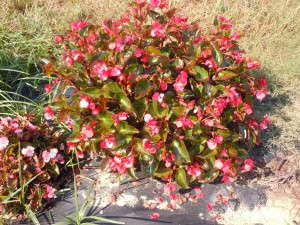Begonias Provide A Shade Alternative
 If you’ve felt the impact of impatiens downy mildew, it’s time to capture maximum share of the increased demand for plants that fulfill shade applications. It’s time to consider begonias.
If you’ve felt the impact of impatiens downy mildew, it’s time to capture maximum share of the increased demand for plants that fulfill shade applications. It’s time to consider begonias.
Because they offer both flower and foliage appeal, expanding your begonia crop can help you meet your customers’ multiple garden needs. From colorful landscape fill to premium shade hanging baskets and interior houseplants, there’s a begonia variety for everyone.
Basket begonia sales are intensifying in the garden center, and for good reason — there’s exciting new breeding coming to market, and the baskets look amazing in the store. Million Kisses is bred to be the most vigorous Begonia boliviensis on the market, with large-size, season-long blooms and the added bonus of low-maintenance and care. The entire series — ‘Elegance,’ ‘Amour,’ ‘Devotion’ and new ‘Honeymoon’ — makes a brilliant display in lush hanging baskets and brings appealing garden color for shade applications.
In the greenhouse, Million Kisses is a breeze to grow. This begonia flowers 10 to 14 days faster than other boliviensis on the market, which allows you to start the crop later and reduce bench time. The following culture tips will help you create stunning containers for retail and fulfill the shade-alternative needs of home gardeners.
Media
Million Kisses begonia prefers a well-drained soil with a pH of 5.8 to 6.2 as the optimum range. Keep night temperatures at 55°F to 60°F and day temperatures at 65°F to 75°F. The crop can be finished cooler in its final weeks of production, maintaining temperatures above 55°F.
Grow Million Kisses under moderate light levels — 3,000 to 4,000 foot candles is the ideal range. Plants may scorch under high light and high temperatures. Longer days promote flowering, so schedule crops to finish under long days (more than 13 hours). Crops produced under short days (less than 12 hours) will result in small plants and poor flowering.
Watering
The media should be allowed to dry between waterings. Water stress can be used for growth control; however, periods of sustained wilting should be avoided. Excess water will result in unwanted stretch and disease.
Fertilizer
Use a constant liquid feed program of 200 to 300 ppm. Regular leaching with clear water will help to reduce buildup of excess salts in media.
Pinching
Million Kisses begonia should be pinched seven to 14 days after transplant to encourage basal branching. Additional pinching can be done as needed. A 4-inch crop can be produced without a pinch in finished production, provided it received a pinch in propagation or at transplant.
Growth Control
Maintain the recommended temperatures and light levels to avoid stretch. Excessive moisture in media will encourage unwanted stretch. Water management is an excellent tool in producing high-quality Million Kisses begonia. Chemical plant growth regulators are generally not needed. Million Kisses begonia is responsive to B-Nine and B-Nine/Cycocel tank mix for finished production in smaller containers. Begin applications seven days after transplant.









